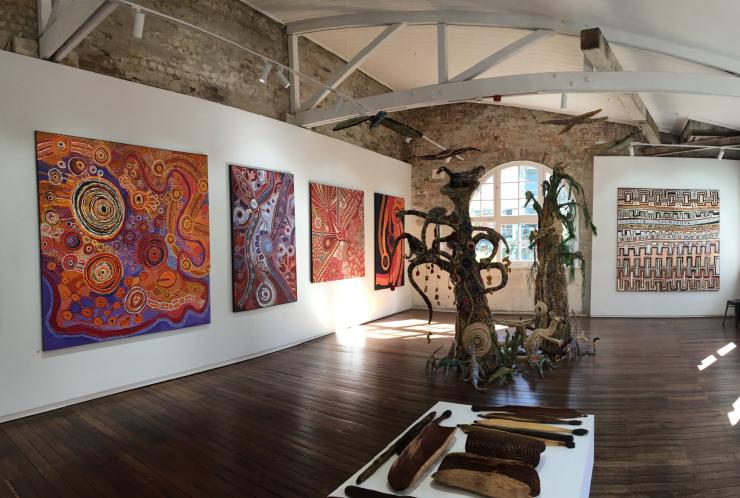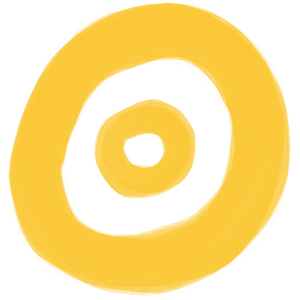
Birrunga Gallery & Dining, Brisbane, Queensland © Tourism and Events Queensland
Where to Buy Aboriginal and Torres Strait Islander Art
Take home the ultimate Australian souvenir with a piece of meaningful art from an artist whose connections to land, lore, and culture stretch back countless generations.
By Paul McBride of Gilimbaa
Your visit to Australia will not only provide unforgettable experiences and memories to last a lifetime, but also the chance to take home your very own memento of the oldest continuing cultures on Earth. For the perfect souvenir of your trip, look no further than Aboriginal and Torres Strait Islander art.
To ensure you are getting an authentic piece of art – and the artist is being fairly compensated – it’s important to purchase from a trusted art dealer (or the artist themselves!). If you’re familiar with a specific artist, be sure to investigate whether they sell directly through a website or social media platform. And if you’re not sure where to start, here are some great places to get your very own authentic artwork created by local Aboriginal and Torres Strait Islander (also called Indigenous or First Nations) artists.
Near Sydney

APY Gallery Australia, Sydney, New South Wales © Apy Gallery

Did you know?
You can also find an APY Art Centre Collective gallery in the South Australian capital of Adelaide.
More Aboriginal people live in New South Wales than in any other state in the country and it is jam-packed with opportunities to connect with culture as a result.
Starting in Sydney, the APY Art Centre Collective is an Indigenous-owned and governed organisation showcasing artworks by dozens of artists from the Anangu Pitjantjatjara Yankunytjatjara lands of remote Central Australia.
Boomalli Aboriginal Artists Cooperative has been operating for over 30 years with the goal of promoting Aboriginal artists whose language groups exist within the New South Wales state boundaries. It offers everything from artworks, clothing and books to stationery and bush medicine.
Near Canberra

Christine West, ‘Minyma Tjuta’, Cat No: X913-14, size 138 x 118 cm, Acrylic on linen © Christine West
Did you know?
Aboriginal artworks are some of the oldest in the world. Rock paintings from Western Australia’s Kimberley region have been dated at 40,000 years old!

Canberra, in the Australian Capital Territory (ACT), may be best known as the home to the country’s federal government, but there’s plenty of Aboriginal and Torres Strait Islander culture to explore, too. Burrunju Aboriginal Corporation’s gallery near the centre of town has a wide variety of artwork, while Art Mark Gallery promotes work by artists from all over Australia, with an online store featuring artworks, scarfs, homewares and more.
Near Brisbane

Aboriginal Art Co, Brisbane, Queensland © Aboriginal Art Co
The multi-award-winning Aboriginal-owned and operated Birrunga Gallery in central Brisbane was founded by Wiradyuri man Birrunga Wiradyuri, and exhibits artworks by a range of Indigenous artists, including Birrunga himself. Take your time to explore the artworks while stopping for a bite to eat or drink in the adjoining café and bar, which serves modern Australian cuisine with a traditional twist.
The Aboriginal-owned and operated Aboriginal Art Co. in South Brisbane is the perfect next stop. Paintings, sculptures, wearable art, homewares and gifts are available. Its owners are also co-directors of Magpie Goose, a popular clothing company promoting and celebrating some of the best Aboriginal and Torres Strait Islander designs.
Near Cairns

Janbal Gallery, Queensland © Tourism Australia
While visiting the must-see Great Barrier Reef in northern Queensland, check out the 100%-Aboriginal-owned and operated Janbal Gallery near Port Douglas. Besides artwork sales, it offers art classes and painting workshops with artist and owner Brian Swindley. The Cooktown-based Kuku Bulkaway Indigenous Art Gallery is owned and operated by the Yuku Baja Muliku people and sells paintings, textiles, jewellery and much more, with purchases helping to support local artists and Indigenous rangers caring for the land and sea.
Near Melbourne

Koorie Heritage Trust tour, Melbourne, Victoria © Archie Sartracom/Tourism Australia
Melbourne’s Koorie Heritage Trust is an Indigenous-owned and managed arts organisation. It’s the perfect place to learn about and connect with the rich cultures of Aboriginal Victoria while perusing exquisite artworks, gifts, books and homewares.
Over at South Wharf, check out a sample of the artwork collection of Red Desert Dreamings, which specialises in Aboriginal art from the red desert area of central Australia, before making an appointment to view the full collection in Port Melbourne. You’ll find a variety of artworks from old masters to up-and-comers.
Near Hobart

Art Mob, Hobart, Tasmania © Art Mob
Whether you’re a seasoned art collector or just beginning your journey of discovering Aboriginal and Torres Strait Islander art, Hobart’s Art Mob has something for everyone. Featuring artworks from the Torres Strait Islands to the Tiwi Islands and the Kimberley, the options are plentiful.
The Aboriginal-owned and operated Blackspace Creative sells authentic and sustainably sourced art and cultural works by artists living and working in Tasmania via its online store. Products include baskets, jewellery, clothing, clapsticks and more.
Near Darwin

Injalak Arts and Crafts, Arnhem Land, Northern Territory © Tourism NT/Felix Baker
Over 30 per cent of the Northern Territory’s population is made up of Aboriginal people, so opportunities to explore First Nations culture are endless in the Top End, from Darwin to Alice Springs and the iconic Uluru.
Injalak Arts lies 300km (186mi) east of Darwin and just one hour from the cultural and natural splendour of Kakadu National Park. It’s the perfect place to be immersed in the cultural artworks of the area, and a fantastic starting point to explore the ancient rock art galleries located nearby. Its online store offers artworks, carvings, textiles and more.
Read next
Ethically Buying Aboriginal and Torres Strait Islander Art
Near Alice Springs and Uluru

Maruku Arts, Uluru Kata Tjuta National Park, Northern Territory © Tourism Australia/NTCB
In Alice Springs is Tangentyere Artists, which is made up of over 400 Central Australian artists. ‘Tangentyere’ is an Arrernte word meaning ‘coming together, working together’, and the depth of cultural diversity of its artists means Tangentyere offers a huge variety of artworks.
Near Uluru is Maruku Arts, which was founded over 30 years ago and is made up of a collective of around 900 artists offering paintings, jewellery, punu (traditional carvings) and more. ‘Maruku’ means ‘belonging to black’, as the centre is owned and operated by Anangu – people of the Central and Western Deserts of Australia. Find the gallery at Uluru-Kata Tjuta National Park Cultural Centre, as well as the opportunity to learn more about workshops, demonstrations, traditional ceremonies and exhibitions.
Near Perth

Yamaji Art, Geraldton, Western Australia © Tourism Western Australia
Just south of Perth, Fremantle’s Artitja Art Gallery is geared towards the more experienced art collector and is open daily by appointment only. The centre offers artworks from over 30 Aboriginal art centres around Western Australia, South Australia and the Northern Territory.
Geraldton’s 100 per cent Indigenous-owned Yamaji Art represents artists from more than five cultural groups, with a focus on sustaining cultural maintenance and arts practices, with an online store offering painting, textiles, weaving, jewellery and prints.
Near Broome

Nagula Jarndu, Broome, Western Australia © Nagula Jarndu
In Western Australia's Pilbara region is Martumili Artists, which was established by Traditional Custodians of an area around the Great Sandy, Little Sandy and Gibson Deserts. The gallery is in the town of Newman, with artists also working across other remote East Pilbara communities, and an online store offers access to a range of vivid and striking pieces from the area.
If you’re heading to the stunning Kimberley region, a stop at Broome’s Nagula Jarndu is a must. ‘Nagula Jarndu’ means ‘saltwater woman’ in Yawuru language, and the centre is now governed by seven Yawuru women directors and has a membership of 120 women. Its online store offers everything from artworks, tote bags, earrings, cushion covers, candles and clothing.
These are just a sample of the many and varied places to buy Aboriginal and Torres Strait Islander art in Australia. Remember to take appropriate steps to ensure the artwork you buy is ethically sourced and sold, and remember that if a gallery or vendor is not First Nations-owned, it's important to check they adhere to the Indigenous Art Code. This will mean you can enjoy your unique souvenir of Australia knowing you have contributed to supporting First Nations artists, families and communities.



































































































































